Understanding Parent And Nested Campaigns
Introduction
Before using the In-App, Monetization Insights, Campaign Cohort, and A/B Test Cohort reports, it is essential to review this article. Understanding the principles outlined here will help ensure accurate data interpretation and effective analysis.
Campaigns in our system are structured into two hierarchical levels, enabling organization through Parent and Nested Campaigns. This means that a group of campaigns can be grouped under a higher-level parent campaign, creating a structured relationship between them.
To clearly define these relationships, we use the following terminology:
- Parent Campaign – A top-level campaign that may contain one or more nested campaigns or exist independently without any nested campaigns.
- Nested Campaign – A child campaign that operates within a parent campaign. All purchases and performance tracking occur at the nested campaign level.
Example: Parent and Nested Campaigns in a Demo Application
The screenshot below illustrates a Parent Campaign containing three Nested Campaigns. When a mobile app user sees this campaign, impression data is sent to analytics for both the Parent Campaign (representing the entire store view) and each of the three Nested Campaigns (representing individual offers).
.jpg)
How Interactions Are Tracked
User interactions such as clicks, purchases, ad views, and bonus claims are associated with specific Product IDs, which correspond to Nested Campaigns.
For example:
- A user sees the Parent Campaign, which features three offers in a single creative.
- They select the first offer ("Standard Pack +100").
- The click action, as well as the purchase transaction (price, quantity, and product details), is attributed specifically to the Nested Campaign linked to this offer.
Why This Structure Matters
This setup enables comprehensive analysis of user behavior:
✅ At the Parent Campaign level – Measure overall impressions, clicks, and conversions for the entire campaign.
✅ At the Nested Campaign level – Identify which specific offer from the campaign generated the highest engagement and purchases.
By leveraging this structure, marketers can assess campaign effectiveness at multiple levels, optimize promotions, and refine in-app store strategies.
How Parent and Nested Campaigns Are Configured in Magify
All offers from the previous screenshot are represented within a Parent Campaign.
The screenshot below shows how this Parent Campaign is structured in the admin panel: it includes all elements that define the campaign, such as creatives, promotions, and offers, presented as a store-like display.
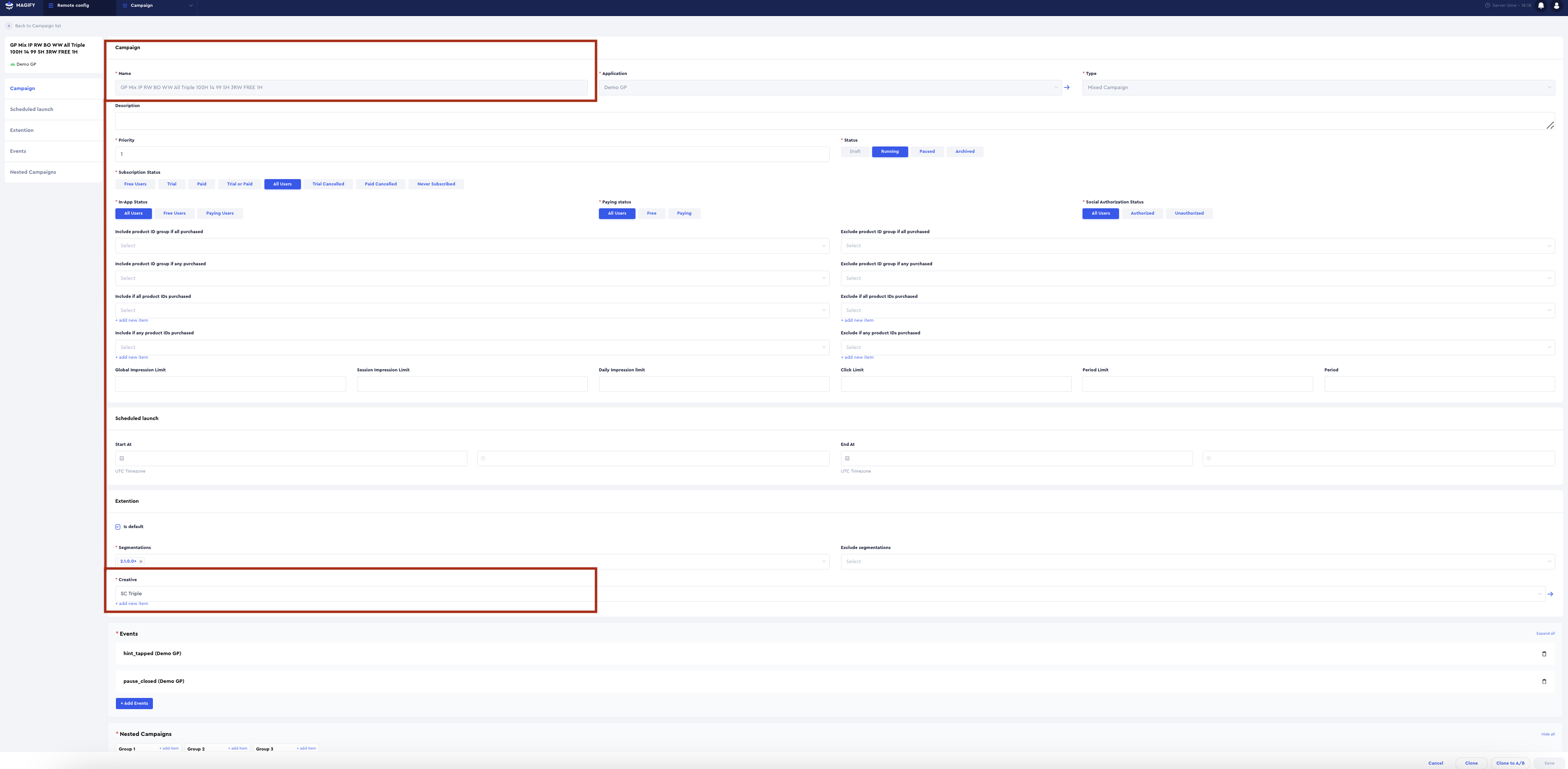
Inside the Parent Campaign, there are three Nested Campaigns, each associated with its own Product ID:
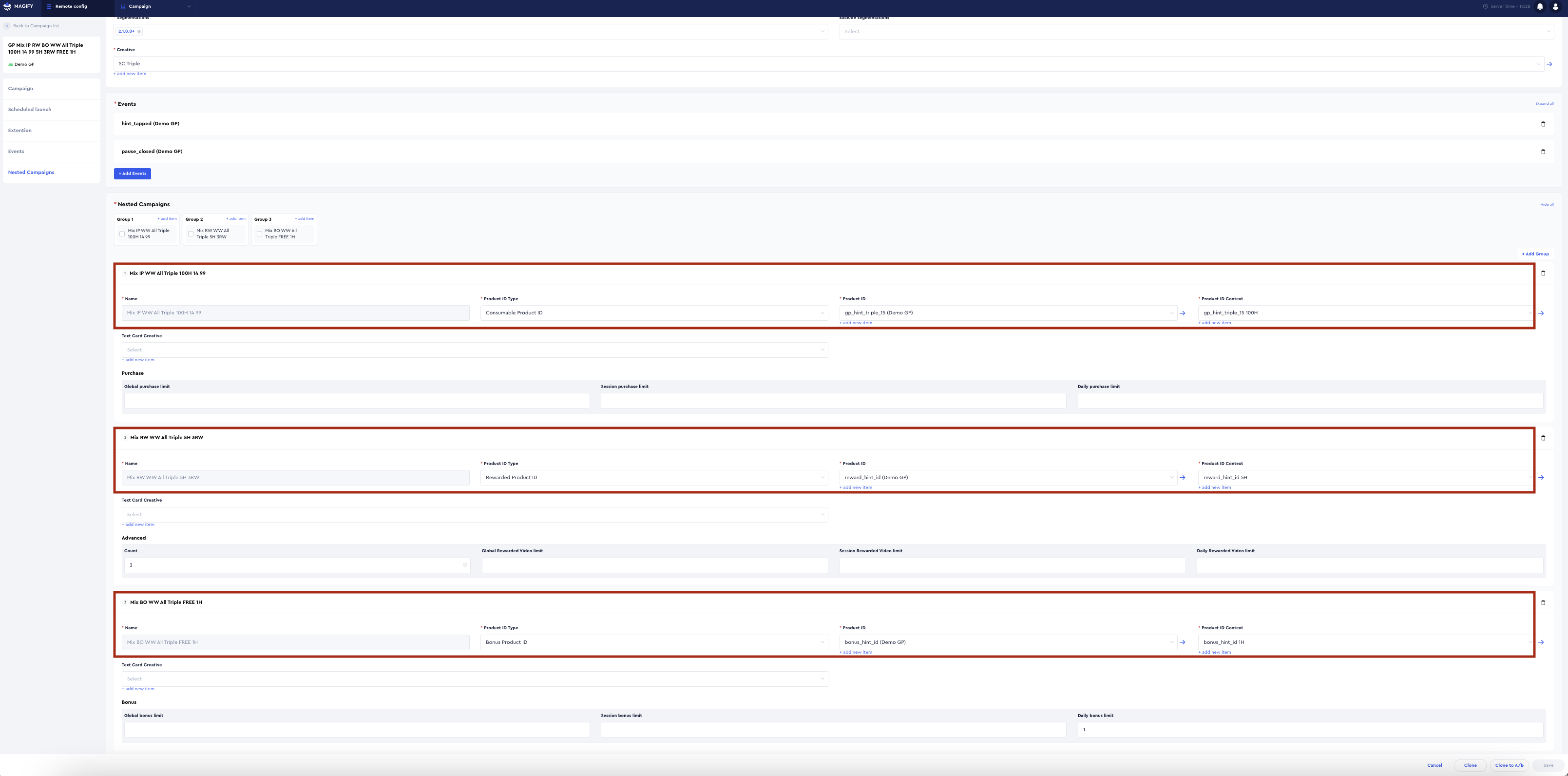
This configuration enables precise tracking and management of each Nested Campaign while maintaining a structured hierarchy within the Parent Campaign.
When analyzing campaign statistics, it is important to remember that, as mentioned earlier, the Impressions metric is collected at both the Parent Campaign and Nested Campaign levels. This means that the number of impressions for a Parent Campaign does not always equal the sum of impressions for its Nested Campaigns, especially in complex monetization setups.
Parent and Nested Campaign Statistics
The key consideration here is that the total number of impressions may vary when transitioning from Parent Campaign statistics to a Nested Campaign breakdown.
How Parent and Nested Campaign Statistics Work
To illustrate the relationship between Parent Campaign and Nested Campaign statistics, consider the following example using in-app campaigns.
Imagine that a Parent Campaign (Parent A) represents an in-game store featuring two offers: Nested B and Nested C. These Nested Campaigns correspond to different in-app purchases with varying prices and bonus structures.
Basic Scenario: Single Parent Campaign with Two Nested Campaigns
If the in-game store (Parent A) receives 10 impressions, the report would display the following:
Parent Campaign-Level Impressions
Nested Campaign-Level Impressions
Advanced Scenario: Different Display Rules for Nested Campaigns
Now, let's consider a more complex setup where each Nested Campaign follows a different display schedule:
- Nested B is shown only on Mondays.
- Nested C is shown only on Tuesdays.
On Monday, the in-game store received 6 impressions, and on Tuesday, it received 4 impressions.
Monday Statistics
Tuesday Statistics
Total Impressions for Both Days
Further Complexity: Adding a Third Nested Campaign
Now, let’s enhance the setup by introducing a third offer (Nested D), which will always be displayed in the store, regardless of the day of the week.
On Monday, the statistics would be:
Monday Statistics
Tuesday Statistics
Total Impressions for Both Days
Key Takeaways
- Parent Campaigns and Nested Campaigns have separate impression counts.
- The number of impressions at the Parent Campaign level does not necessarily equal the sum of Nested Campaign impressions.
- Nested Campaign impressions depend on their display conditions.
- Some offers may appear only on specific days, impacting overall statistics.
- A Nested Campaign always tracks impressions independently, even if multiple offers exist under the same Parent Campaign.
This structure allows for granular analysis of user engagement with each offer while maintaining a holistic view of store performance at the Parent Campaign level.
We also have campaign-related data that determines how Impressions statistics are displayed — either at the Parent Campaign level or the Nested Campaign level.
When filtering (selecting a value in the report’s top filter) or breaking down data (activating a dimension in the table) by:
- Product ID
- Product ID Type
- Nested Monetization Model
the Impressions metric will always be displayed at the Nested Campaign level. This limitation arises because Product ID, Product ID Type, and Nested Monetization Model are attributes exclusive to Nested Campaigns and are not applicable at the Parent Campaign level. As a result, the report automatically switches to the Nested Campaigns level.
Filters and Dimensions: Product ID & Creative Example
How These Filters and Dimensions Work: Example with Product ID and Creative
For example, when the Creative dimension is activated, the report displays the total number of Impressions at the Parent Campaign level:
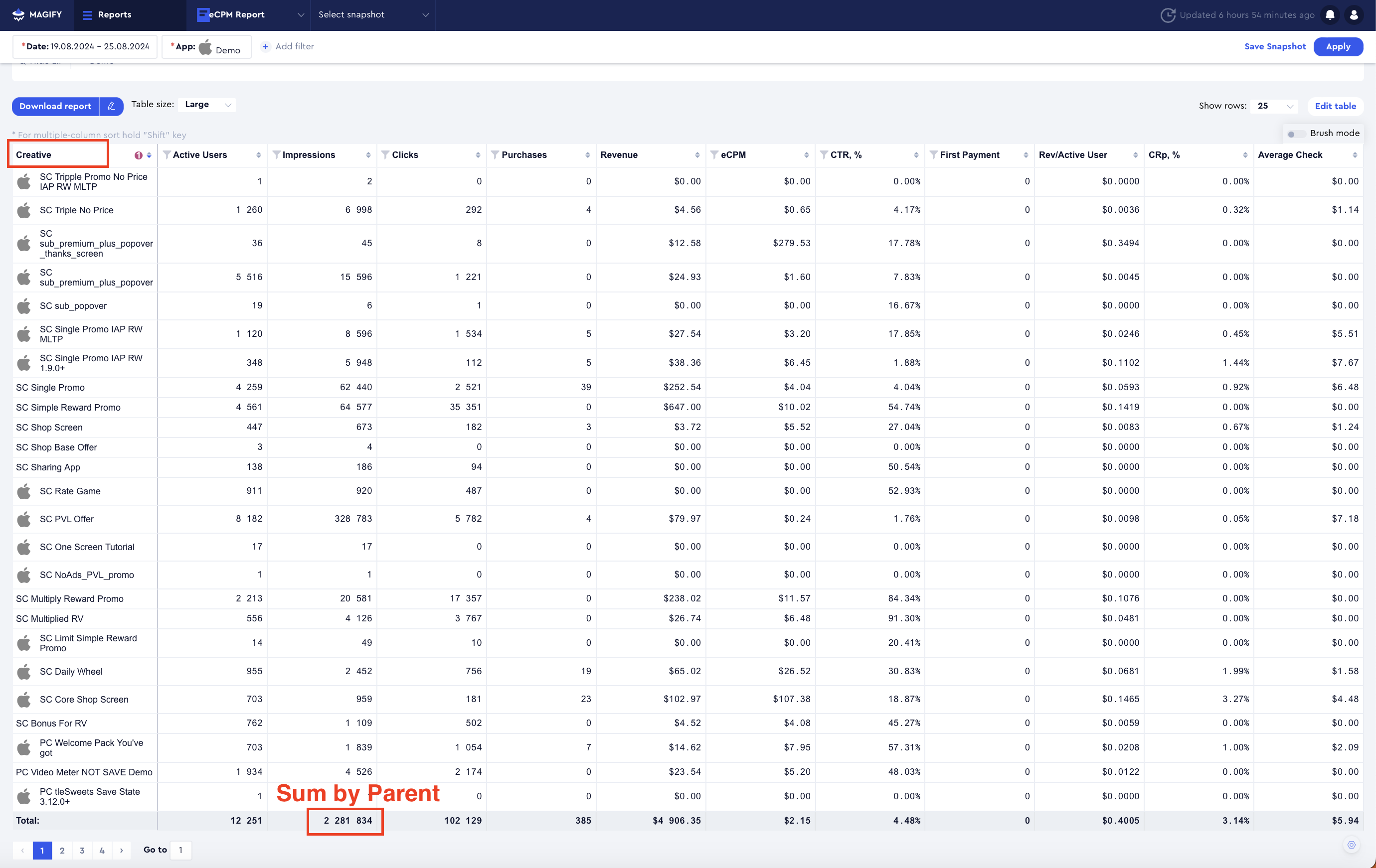
However, as soon as a second active dimension is added for Product (Product ID), the report immediately switches to displaying Impressions at the Nested Campaign level.
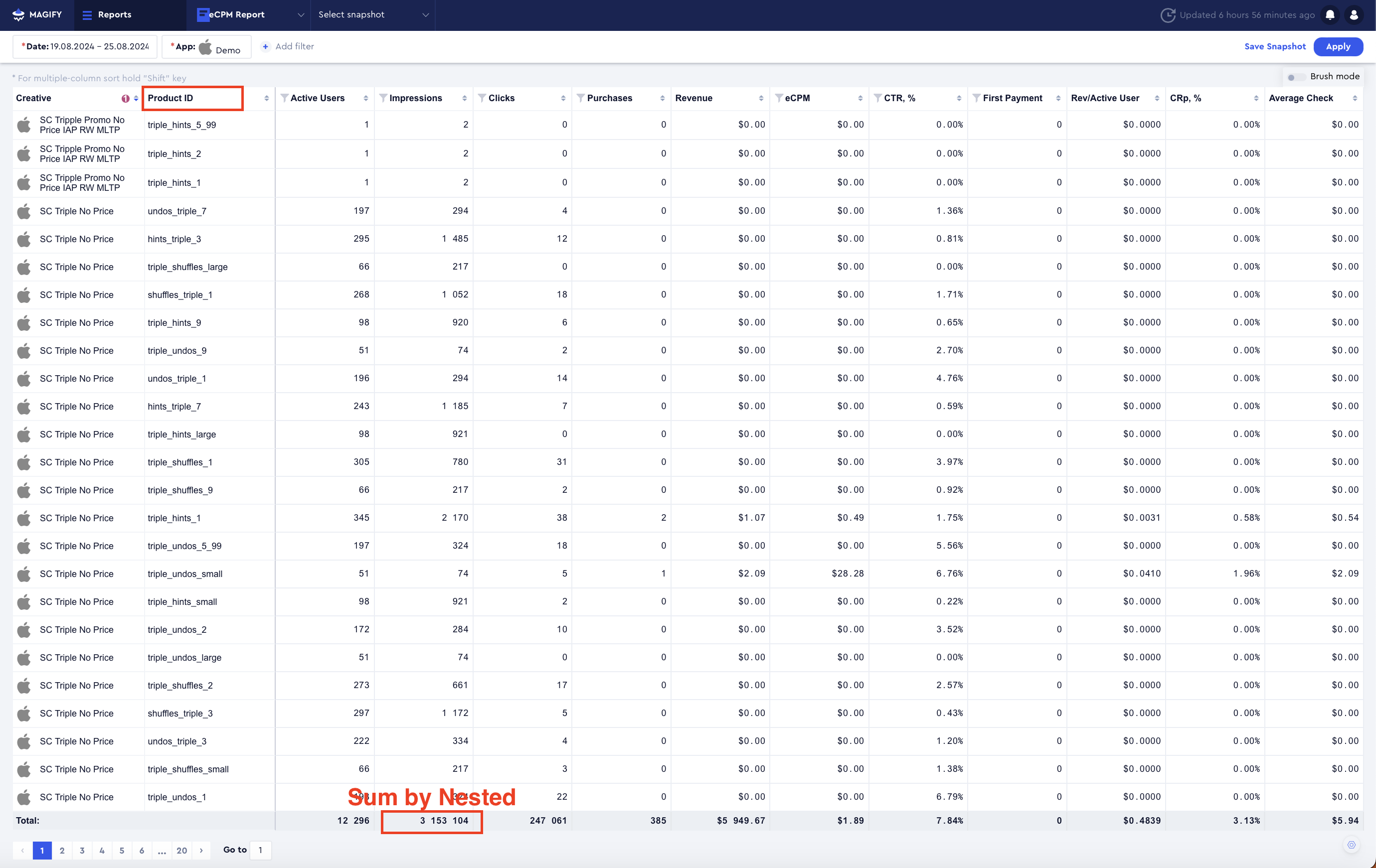
Parent Campaign statistics are useful for comparing two creatives at a high level.
Nested Campaign statistics are useful for analyzing how the same product performs across different creatives.
Working with Products and Creatives
Examples: How to Work with Products and Creatives
To compare the performance of multiple creatives, the recommended approach is to select the desired creatives in the Creative filter and use Creative as a breakdown dimension.
In this case, the report will display statistics at the Parent Campaign level, as creatives are linked to Parent Campaigns:
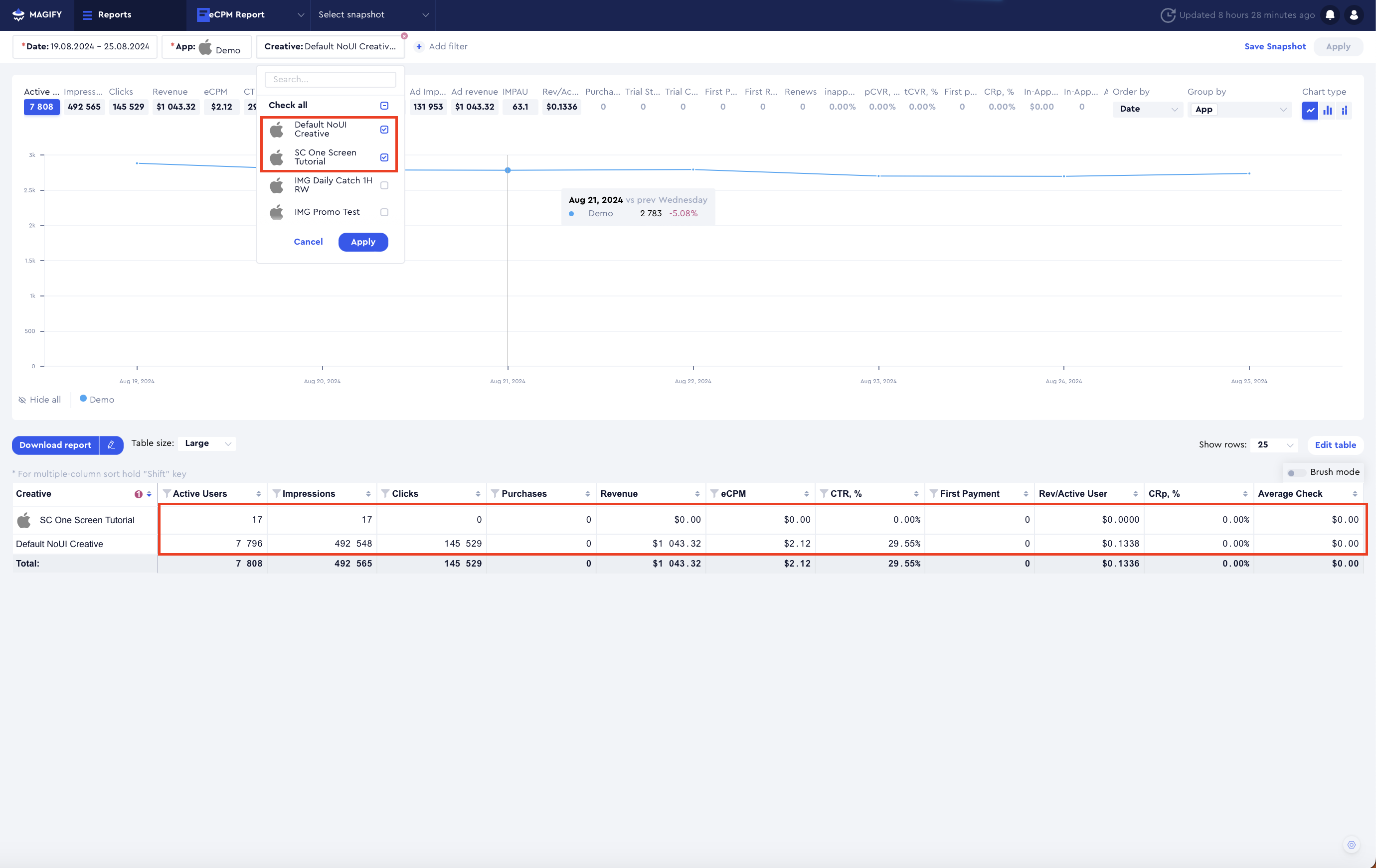
If the goal is to compare the performance of the same product across different creatives, the best approach is to select the product in the filter and apply a breakdown by both Product and Creative dimensions.
In this case, the report will display statistics at the Nested Campaign level for all campaigns associated with the selected product. Additionally, the Creative value will be displayed from the Parent Campaign that includes these Nested Campaigns.
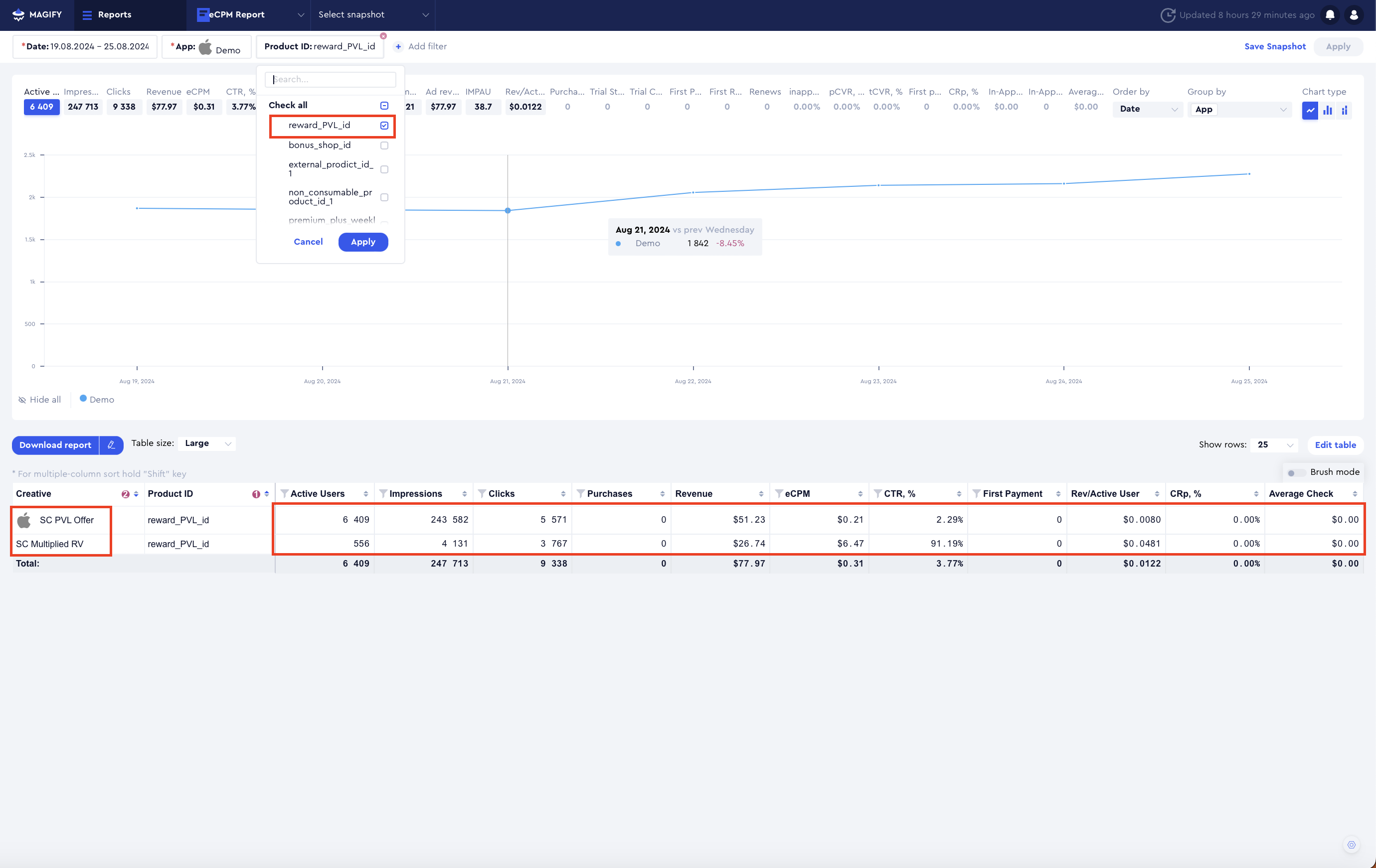
If the goal is to gather overall statistics for a product, the best approach is to select the product in both the filter and dimensions.
In this case, the report will display statistics at the Nested Campaign level for all campaigns associated with the selected product.
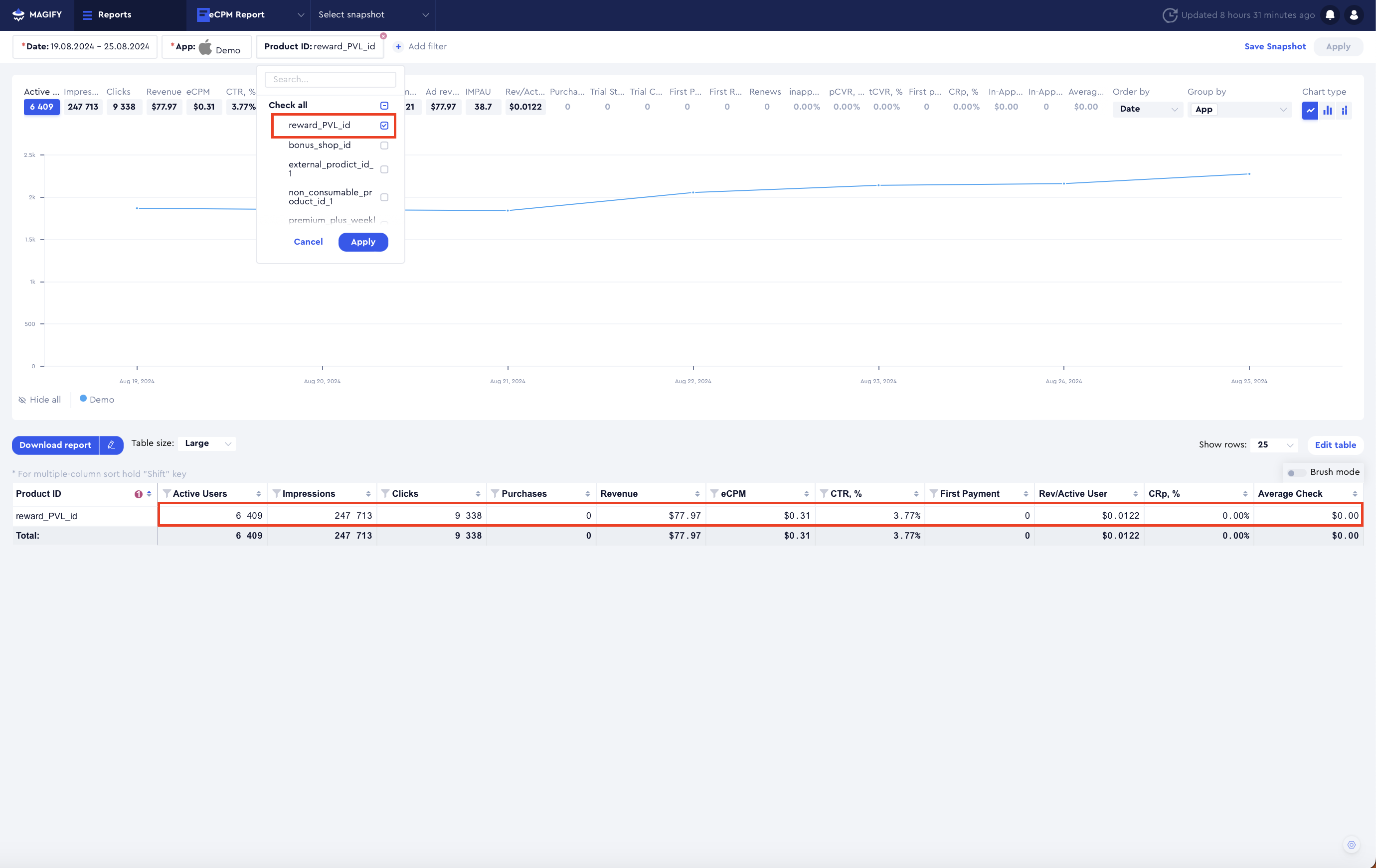
Filtering by Campaign Type: Important Considerations
Use caution when filtering by Campaign Type, as this filter includes all available campaign types in Magify—both at the Parent Campaign and Nested Campaign levels.
When selecting multiple campaign types at the same time, ensure that all selected types belong exclusively to either Parent or Nested levels. Nested Campaign types can be easily identified, as they always start with the word "Nested" in their names.
Additionally, other filters are directly related to the Campaign Type filter. Do not select Parent Campaign types while simultaneously using filters designed for Nested Campaigns, such as:
- Product ID
- Product ID Type
- Nested Monetization Model
Doing so may result in missing data in the report.
Campaign Type Filter Examples
Examples of Using the Campaign Type Filter
For example, it is incorrect to select both Nested Campaigns and Creatives simultaneously. Creatives are an attribute of Parent Campaigns, and filtering by both levels at the same time will result in no data being displayed.
This happens because filtering by both Parent and Nested campaign levels simultaneously creates a data conflict in the report.
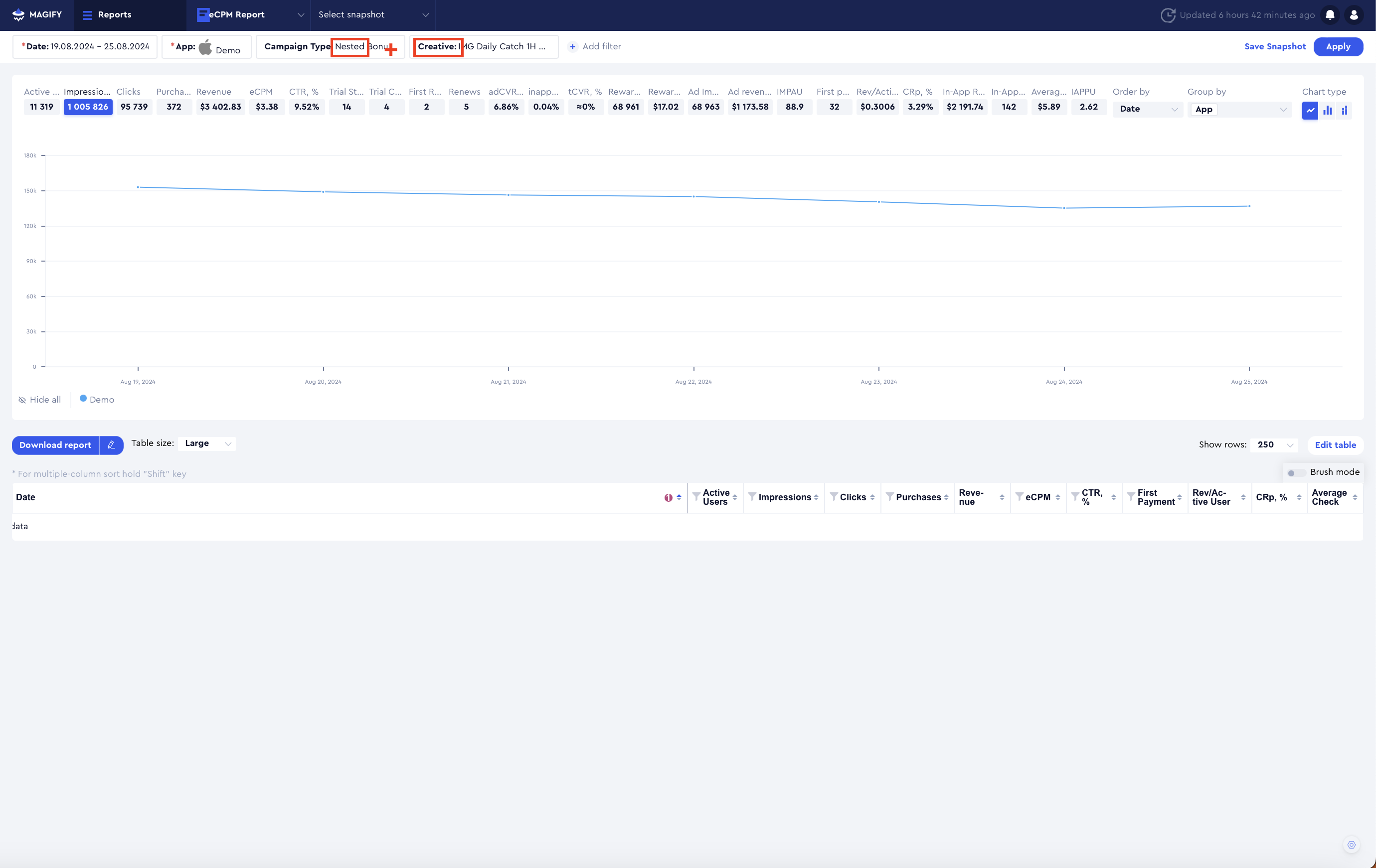
This situation can be resolved in two ways:
Remove the Campaign Type filter altogether. Since selecting a Creative automatically includes all associated Parent Campaigns, additional filtering by Campaign Type is unnecessary.
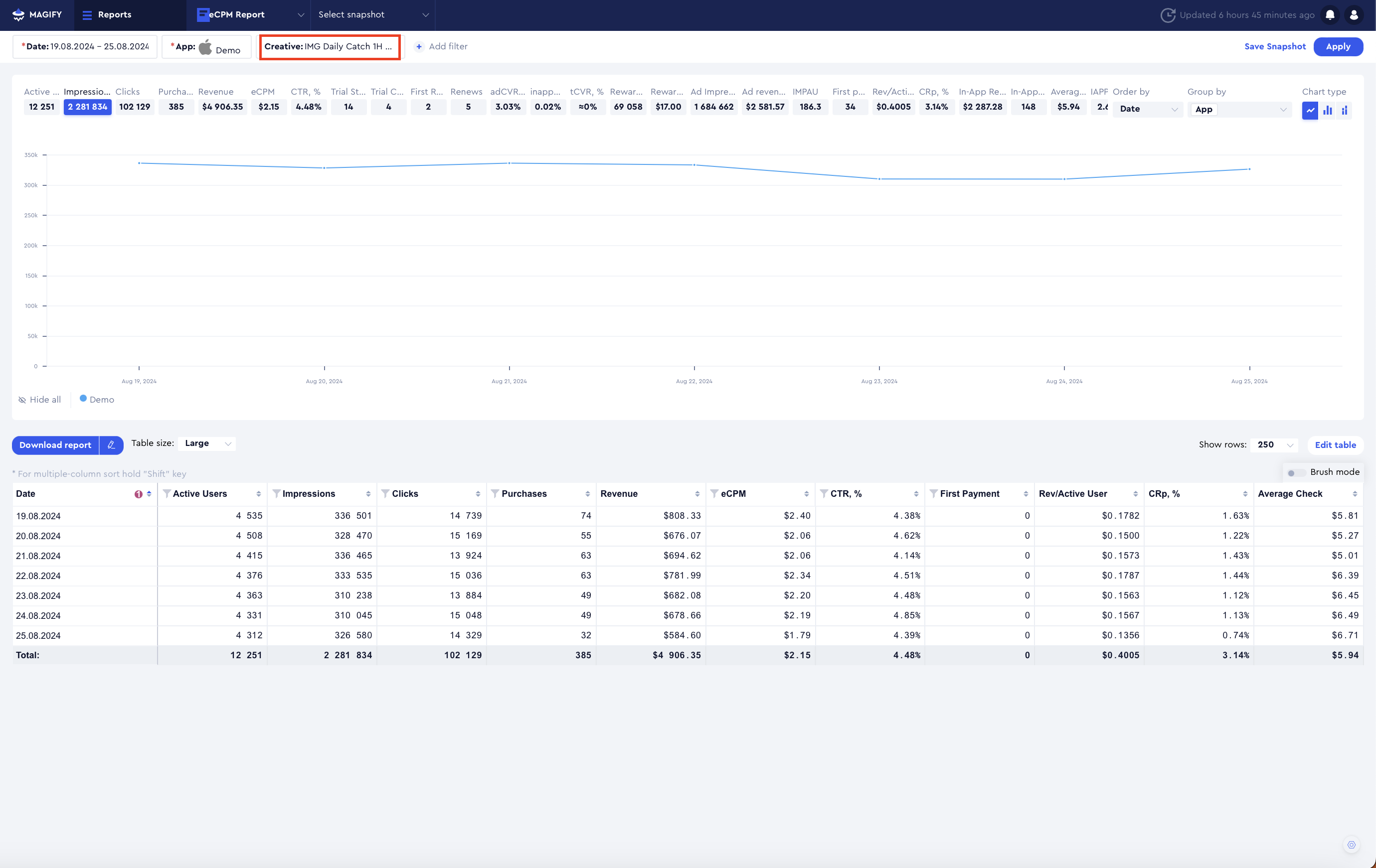
Manually select the appropriate Parent Campaign types. Ensure that the selected campaign types do not start with "Nested", as only Parent Campaigns should be included in this case.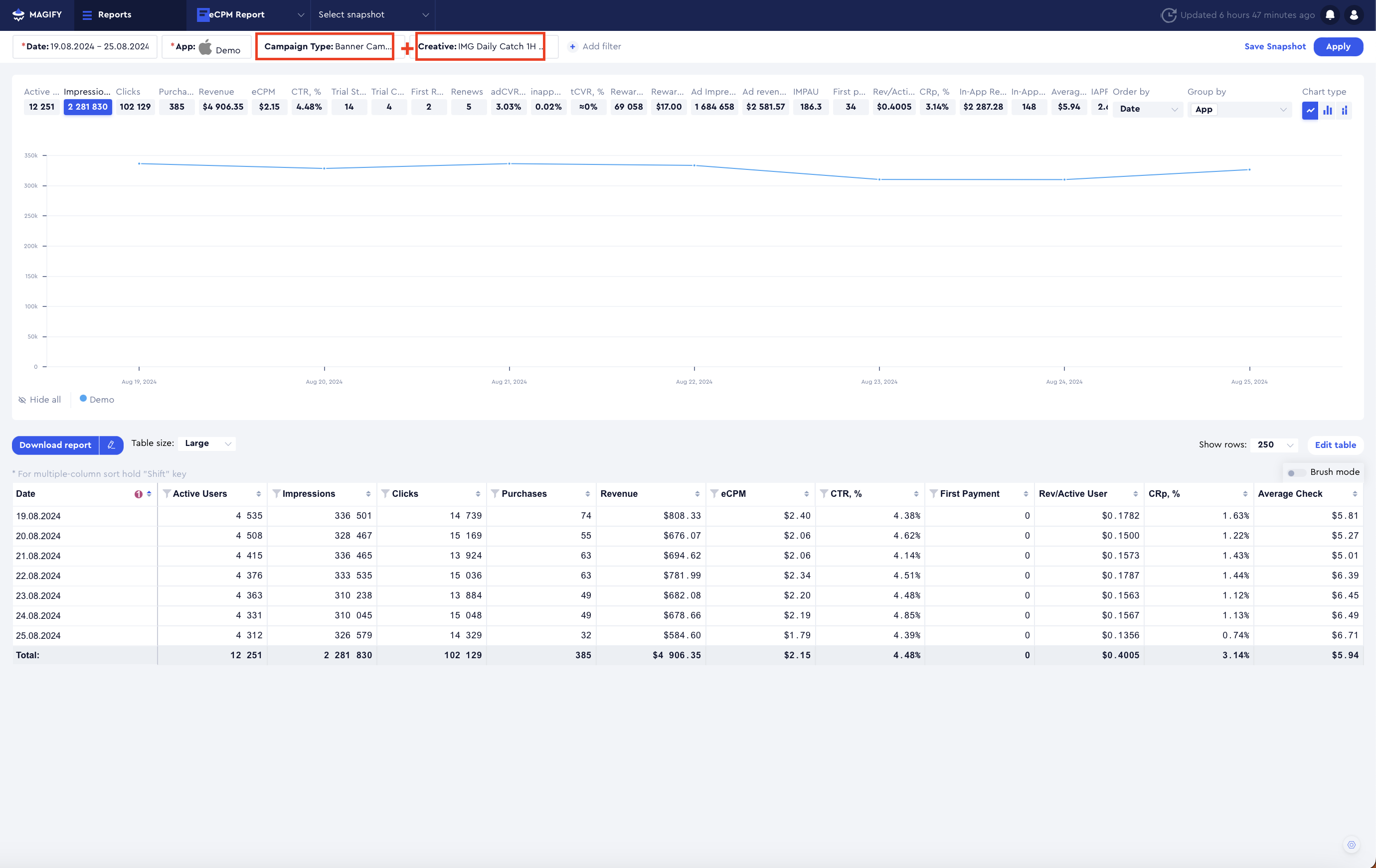
In Magify, the campaign name serves as the fundamental unit for collecting statistics in this report. To ensure the most accurate data collection, it is best to work directly with campaign names rather than relying solely on associated metadata.
For easier navigation and filtering, we recommend using keywords in your campaign names, allowing you to quickly find relevant campaigns among all available filter values.
Additionally, the Snapshots feature is a useful tool for saving and sharing pre-configured filter selections, enabling seamless collaboration with other users.